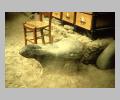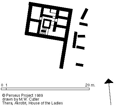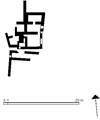
Fresco of young priestess from room 4 of the West House, Akrotiri, Thera.

Detail of left boxer, fresco of the boxing children, house beta, Akrotiri,...

Fresco fragment from the House of the Ladies, Akrotiri, Thera.
| Summary: | Cycladic Bronze Age settlement destroyed by volcanic eruption. |
| Type: | Settlement |
| Region: | Cyclades |
Periods:
Middle Bronze Age
Late Bronze Age
Physical:
The site of Akrotiri is located in the SW of the island of Thera, above a sheltered S facing bay and with a view to Crete, ca. 110 km to the S. The Bronze Age settlement (over 10,000 sq m) was at the zenith of its development when it was completely buried by ash and pumice following a volcanic eruption (dated at ca. 1500 B.C.) that has been estimated as 4 times as powerful as the Krakatoa eruption of 1883 A.D. The extensive architectural remains and well preserved wall paintings have led to a comparison with Roman Pompeii. The destruction may have given rise to the Atlantis myth.
Description:
The earliest evidence for settlement at Akrotiri dates to the Early Bronze Age II and III periods. The pottery and artifacts of this phase show connections to the N Aegean islands.
In the Middle Bronze Age the size of the settlement expands and artifacts now show closer connections with Mainland Greece. The 1st Minoan influence is also seen at the site in this period. The transition from Middle Bronze Age to Late Bronze Age passes with no cultural break, but was marred by an earthquake (at ca. 1550 B.C.) which caused great damage to the settlement. The inhabitants apparently rebuilt their city immediately and in an even more luxurious and larger scale.
The size of the Late Bronze Age I settlement is estimated to have been several thousand inhabitants. The wealth and size of the city, with paved streets, city sewer system, and 2 and 3 story private houses with magnificent wall paintings, indoor toilets and rich furnishings certainly equalled or surpassed the level of culture and wealth on Minoan Crete. The settlement at Akrotiri probably gained this high degree of wealth and culture through its foreign contacts and its position in the center of the Aegean trade networks.
At ca. 1500 B.C. earthquake tremors again caused damage to the city. There is evidence that immediately afterwards the inhabitants began again to clean up debris and repair the damage. Before the repairs were completed, however, the inhabitants were forewarned (possibly from gas or smoke from the volcano) of the coming eruption (no human remains or valuables have been found during the excavations). The eruption buried Akrotiri under 5 m of ash and pumice. At least 200 years passed before the island of Thera was again inhabited, and there is no evidence for a settlement on the island again until the Archaic period.
Exploration:
Exploration began in 1845 and systematic excavations were carried out 1895-1903, then resumed after WWII under S. Marinatos and up to present under C. Doumas.
Sources Used:
Other Bibliography:


